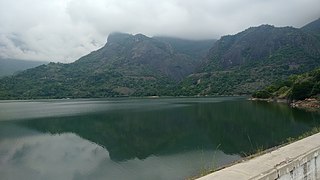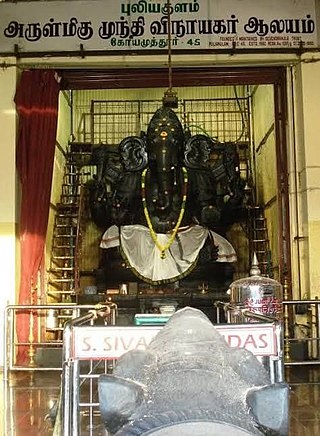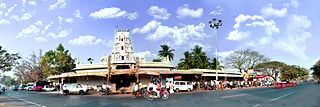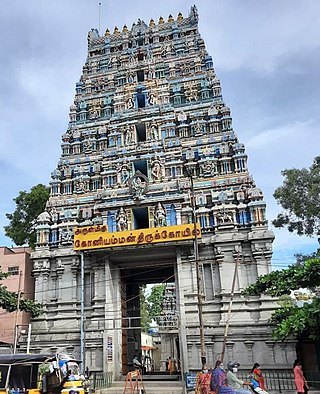
Coimbatore, sometimes shortened as Kovai, is one of the major metropolitan cities in the Indian state of Tamil Nadu. It is located on the banks of the Noyyal River and surrounded by the Western Ghats. Coimbatore is the second largest city in Tamil Nadu after Chennai in terms of population and the 16th largest urban agglomeration in India as per the census 2011. It is the administrative capital of Coimbatore District and is administered by the Coimbatore Municipal Corporation which was established in 1981.

Namakkal is a City and the headquarters of Namakkal district in the Indian state of Tamil Nadu. It is the first ISO 14001-2004 certified municipality in Asia for environmental management, specifically the provision and maintenance of water supply, solid waste and sewage management, town planning, lighting and other social services. Namakkal is known as the Egg City due to its large egg production and Transport city.

Gobichettipalayam is a town and municipality in Erode district of the Indian state of Tamil Nadu. It is the administrative headquarters of Gobichettipalayam taluk. It is situated at the center of the South Indian Peninsula at 213 metres (699 ft) above sea level, surrounded by Western Ghats. It is located 35 kilometres (22 mi) from the district headquarters Erode, 44 kilometres (27 mi) from Tiruppur and 80 kilometres (50 mi) from Coimbatore. Agriculture and textile industries contribute majorly to the economy of the town.

Bhavani is a Municipality in Erode District, Tamil Nadu, India. It is located at the northern periphery of Erode City Municipal Corporation and is around 105 km (65 mi) from Coimbatore and 60 km (37 mi) from Tiruppur and Salem. Bhavani is also known as "Carpet City" as it is known for its carpet industry; blankets and carpets manufactured in the town are known as Bhavani Jamakkalam. As of 2011, the town covers an area of 2.17 square kilometres (0.84 sq mi) and has a population of 39,225. It is a grade II municipality.

Kongu Nadu, also known as Kongu Mandalam, is a geographical region comprising the western part of the Indian state of Tamil Nadu and parts of southeastern Karnataka and eastern Kerala. The region covers an area of roughly 60,895 km2 (23,512 sq mi) with a population of over 27.4 million.

Temple cars or Temple chariots are used to carry representations of Hindu gods around the streets of the temple on festival days. These chariots are generally manually pulled by the devotees of the deity.

Coimbatore district is one of the 38 districts in the state of Tamil Nadu in India. Coimbatore is the administrative headquarters of the district. It is one of the most industrialized districts and a major textile, industrial, commercial, educational, information technology, healthcare and manufacturing hub of Tamil Nadu. The region is bounded by Tiruppur district in the east, Nilgiris district in the north, Erode district in the northeast, Palakkad district, Idukki district and small parts of Thrissur district and Ernakulam district of neighboring state of Kerala in the west and south respectively. As of 2011, Coimbatore district had a population of 3,458,045 with a sex ratio of 1,000 and literacy rate of 84%.

Pollachi is a town and a taluk headquarters in Tamil Nadu state, India. Located about 40 km (25 mi) to the south of Coimbatore, it is the second largest town in the district after Coimbatore. Pollachi is a popular marketplace for jaggery, vegetables and cattle. As of 2011, the town had a population of 90,180. Another name for Pollachi is "Mother of Nature".
Chennimalai is a town in Erode district, Tamil Nadu, India. It is popularly known as the 'Handloom Town'.
Kinathukadavu, meaning Pass of the Well, is a town panchayat suburb of Coimbatore city and taluk in Coimbatore district in the Indian state of Tamil Nadu. It is along the National Highway 209 and is 23 kilometres (14 mi) from Gandhipuram heart of Coimbatore city and 20.5 kilometres (13 mi) from Pollachi town.

Vellalore is a panchayat town in Coimbatore district in the Indian state of Tamil Nadu. It is a southern suburb of the city. It is at 12 km east of Townhall, the centre of the city Coimbatore. It is situated on the southern bank of Noyyal river.

Avinashi is a municipality in the Tiruppur district in the Indian state of Tamil Nadu. Avinashi is one among the nine taluks of the district. It is one of the most popular pilgrim destinations in the Western Tamil Nadu region. It is located off of National Highway NH544, which bypasses the town. The history of the town is centered around the Avinasilingeswarar temple. The town was previously a part of the Coimbatore district until Tirupur was carved out as a separate district from the erstwhile districts of Coimbatore and Erode. It is a stopping place for vehicles travelling from the western part of Tamil Nadu to Chennai and Cochin.
Tamil Nadu is the southernmost state of India located on south-eastern coast of the Indian peninsula. The state is straddled by Western Ghats and Eastern Ghats to the west and north and the waters of Bay of Bengal and Andaman Sea on the other two sides. It is the home of the Tamil people, who speak Tamil language, one of the oldest surviving languages. The capital and largest city is Chennai which is known as the "Gateway to South India". As of 2021, the state is the most visited and has received the most number of tourists amongst all states of India.

Perur Pateeswarar Temple is a Hindu temple dedicated to Lord Shiva located at Perur, in western part of Coimbatore in state of Tamil Nadu in India. The temple was built by Karikala Chola in 2nd century CE. The temple is located on the bank of the Noyyal River and has been patronized by poets like Arunagirinathar and Kachiappa Munivar. Lord Shiva, known as ‘Patteeswarar’, is the presiding deity of this temple together with his consort Parvati, who is known as ‘Pachainayaki’. The deity is believed to be ‘Swayambu Lingam’ (self-emerged).

Puliakulam is a residential neighborhood in the city of Coimbatore. The Idol in Puliakulam Vinayagar Temple is one of the largest monolithic(Single stoned) statues and the largest Ganesha idol in Asia. The Temple is Situated on the middle of the Four road Junction and also acts as a roundabout for the Vehicles to pass by. The idol is in the East facing facing the Meena estate and the Sowripalayam Road.

Eachanari Vinayagar Temple is a temple dedicated to Hindu god Vinayagar, situated in the village Eachanari near Coimbatore, Tamil Nadu, India. The temple is situated about 12 km from the city of Coimbatore on NH 209.

Arulmigu Koniamman Temple, is a historic Hindu temple located on the northern bank of the Noyyal River of Coimbatore, Tamil Nadu, India. It is dedicated to the goddess Koniamman, a form of Parvati. The temple is at the center of the city of Coimbatore in the core of the city, Town Hall, Coimbatore, Tamil Nadu, India. Koniamman is the "Guardian Deity" of the city. This temple is one of the twin historic temples in the city, the other being Perur Pateewarar Temple.
Thandu Mariamman Temple is a Hindu temple dedicated to Thandu Mariamman located in Uppilipalayam, Coimbatore, Tamil Nadu, India. According to mythology, the goddess is said to have cured the soldiers of the ruler of Kongu Nadu from chicken pox. The annual car festival celebrated in April is one of the important religious festivals in the region.
Eachanari is a suburb of Coimbatore city in Tamil Nadu, India. The suburb and its environs are also home to the Eachanari Vinayagar Temple. It exists within the Coimbatore City Municipal Corporation jurisdiction.

















